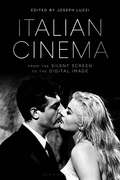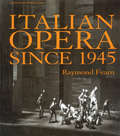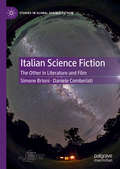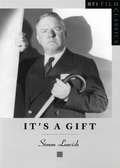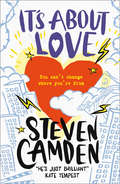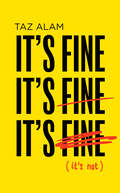- Table View
- List View
Italian Cinema from the Silent Screen to the Digital Image
In this comprehensive guide, some of the world's leading scholars consider the issues, films, and filmmakers that have given Italian cinema its enduring appeal. Readers will explore the work of such directors as Federico Fellini, Michelangelo Antonioni, and Roberto Rossellini as well as a host of subjects including the Italian silent screen, the political influence of Fascism on the movies, lesser known genres such as the giallo (horror film) and Spaghetti Western, and the role of women in the Italian film industry. Italian Cinema from the Silent Screen to the Digital Image explores recent developments in cinema studies such as digital performance, the role of media and the Internet, neuroscience in film criticism, and the increased role that immigrants are playing in the nation's cinema.
The Italian Commedia and Please be Gentle
by David GriffithsFocusing on Commedia Dell'Arte, this work provides a historical and critical commentary of the Commedia. It highlights common factors between this genre and that of the Japanese Noh theatre. The author proposes six similarities: characters familiar to their audience and masked, minimal properties and scenery with the focus on the actor, the "families" of performers, a sharp mind as well as an agile body, a professional living on these skills and patronage, and a knowledgeable audience. Complementing this book is the play "Please Be Gentle" which explores the various tricks and devices of Commedia Dell'Arte acting.
The Italian Commedia and Please be Gentle
by David GriffithsFocusing on Commedia Dell'Arte, this work provides a historical and critical commentary of the Commedia. It highlights common factors between this genre and that of the Japanese Noh theatre. The author proposes six similarities: characters familiar to their audience and masked, minimal properties and scenery with the focus on the actor, the "families" of performers, a sharp mind as well as an agile body, a professional living on these skills and patronage, and a knowledgeable audience. Complementing this book is the play "Please Be Gentle" which explores the various tricks and devices of Commedia Dell'Arte acting.
Italian Film in the Light of Neorealism
by Millicent MarcusThe movement known as neorealism lasted seven years, generated only twenty-one films, failed at the box office, and fell short of its didactic and aesthetic aspirations. Yet it exerted such a profound influence on Italian cinema that all the best postwar directors had to come to terms with it, whether in seeming imitation (the early Olmi), in commercial exploitation (the middle Comencini) or in ostensible rejection (the recent Tavianis). Despite the reactionary pressures of the marketplace and the highly personalized visions of Fellini, Antonioni. And Visconti, Italian cinema has maintained its moral commitment to use the medium in socially responsible ways--if not to change the world, as the first neorealists hoped, then at least to move filmgoers to face the pressing economic, political, and human problems in their midst. From Rossellini's Open City (1945) to the Taviani brothers' Night of the Shooting Stars (1982). The author does close readings of seventeen films that tell the story of neorealism's evolving influence on Italian postwar cinematic expression.Other films discussed are De Sica's Bicycle Thief and Umberto D. De Santis's Bitter Rice, Comencini's Bread, Love, and Fantasy, Fellini's La strada, Visconti's Senso, Antonioni's Red Desert, Olmi's Il Posto, Germi's Seduced and Abandoned, Pasolini's Teorema, Petri's Investigation of a Citizen above Suspicion, Bertolucci's The Conformist, Rosi's Christ Stopped at Eboli, and Wertmuller's Love and Anarchy, Scola's We All Loved Each Other So Much provides the occasion for the author's own retrospective consideration of how Italian cinema has fulfilled, or disappointed, the promise of neorealism.
Italian Motherhood on Screen
by Giovanna Faleschini Lerner Maria Elena D’amelioThis book is the first scholarly analysis that considers the specificity of situated experiences of the maternal from a variety of theoretical perspectives. From “Fertility Day” to “Family Day,” the concept of motherhood has been at the center of the public debate in contemporary Italy, partly in response to the perceived crisis of the family, the economic crisis, and the crisis of national identity, provoked by the forces of globalization and migration, secularization, and the instability of labor markets. Through essays by an international cohort of established and emerging scholars, this volume aims to read these shifts in cinematic terms. How does Italian cinema represent, negotiate, and elaborate changing definitions of motherhood in narrative, formal, and stylistic terms? The essays in this volume focus on the figures of working mothers, women who opt for a child-free adulthood, single mothers, ambivalent mothers, lost mothers, or imperfect mothers, who populate contemporary screen narratives.
Italian Motherhood on Screen
by Giovanna Faleschini Lerner Maria Elena D’amelioThis book is the first scholarly analysis that considers the specificity of situated experiences of the maternal from a variety of theoretical perspectives. From “Fertility Day” to “Family Day,” the concept of motherhood has been at the center of the public debate in contemporary Italy, partly in response to the perceived crisis of the family, the economic crisis, and the crisis of national identity, provoked by the forces of globalization and migration, secularization, and the instability of labor markets. Through essays by an international cohort of established and emerging scholars, this volume aims to read these shifts in cinematic terms. How does Italian cinema represent, negotiate, and elaborate changing definitions of motherhood in narrative, formal, and stylistic terms? The essays in this volume focus on the figures of working mothers, women who opt for a child-free adulthood, single mothers, ambivalent mothers, lost mothers, or imperfect mothers, who populate contemporary screen narratives.
Italian Neorealist Cinema (Traditions In World Cinema Ser.)
by Torunn HaalandHow has Italian neorealist cinema changed the boundaries of cinematic narration and representation? In this new study, Torunn Haaland argues that neorealism was a cultural moment based on individual optiques. She accounts for the tradition’s coherence in terms of its moral commitment to creating critical viewing experiences around underrepresented realities and marginalised people. By examining both acclaimed masterpieces and lesser known works, parallels are drawn to realist theories and to past and present cinematic traditions. The ways in which successive generations of directors have readopted, negotiated and broken with the themes and aesthetics of neorealist film are discussed and evaluated, along with neorealist tendencies in other arts, such as literature. An engaging and informative read for students and scholars in Italian Studies, Italian Neorealist Cinema presents a new approach to a key cinematic tradition, and so is essential reading for everyone working in the field of Film Studies.
Italian Neorealist Cinema (Traditions in World Cinema)
by Torunn HaalandThis book traces the roots of neorealist film and draws parallels to neorealist fiction, by surveying the major creative contributions to and critical receptions of this trend in Italian postwar cinema.
Italian Opera Since 1945 (Contemporary Music Studies)
by Raymond FearnFirst Published in 1998. Routledge is an imprint of Taylor & Francis, an informa company.
Italian Opera Since 1945 (Contemporary Music Studies #Vol. 15)
by Raymond FearnFirst Published in 1998. Routledge is an imprint of Taylor & Francis, an informa company.
Italian Post-Neorealist Cinema (Traditions In World Cinema Ser.)
by Luca BarattoniUnlike countries like France, the Czech Republic or Brazil, Italy did not have a new wave properly understood as a movement. However, while new artistic schools were emerging in many other countries, Italy was undergoing its most dramatic social and economic transformations. Those violent changes, together with the perceived necessity of renewing the aesthetic heritage of Neorealism, sparked a drastic regeneration of the cinematic language and marked the most memorable period of Italian film history.Italian Post-Neorealist Cinema explores the ferments of Italian cinema from the mid-50s to the end of the 60s, situating its wealth in the context of other national cinemas emerging at the same time. Olmi, Pasolini, Antonioni, Fellini, Visconti, the Taviani Brothers, Cavani, Rosi, Ferreri and many others all made their debut or directed their most representative works during the period. The book brings to the surface the lines of experimentation and artistic renewal appearing after the exhaustion of Neorealism, mapping complex areas of interest such as the emergence of ethical concerns, the relationship between ideology and representation, and the role of Italian counter-culture.
Italian Post-Neorealist Cinema (Traditions in World Cinema)
by Luca BarattoniUnlike countries like France, the Czech Republic or Brazil, Italy did not have a new wave properly understood as a movement. However, while new artistic schools were emerging in many other countries, Italy was undergoing its most dramatic social and economic transformations. Those violent changes, together with the perceived necessity of renewing the aesthetic heritage of Neorealism, sparked a drastic regeneration of the cinematic language and marked the most memorable period of Italian film history.Italian Post-Neorealist Cinema explores the ferments of Italian cinema from the mid-50s to the end of the 60s, situating its wealth in the context of other national cinemas emerging at the same time. Olmi, Pasolini, Antonioni, Fellini, Visconti, the Taviani Brothers, Cavani, Rosi, Ferreri and many others all made their debut or directed their most representative works during the period. The book brings to the surface the lines of experimentation and artistic renewal appearing after the exhaustion of Neorealism, mapping complex areas of interest such as the emergence of ethical concerns, the relationship between ideology and representation, and the role of Italian counter-culture.
Italian Science Fiction: The Other in Literature and Film (Studies in Global Science Fiction)
by Simone Brioni Daniele ComberiatiThis book explores Italian science fiction from 1861, the year of Italy’s unification, to the present day, focusing on how this genre helped shape notions of Otherness and Normalness. In particular, Italian Science Fiction draws upon critical race studies, postcolonial theory, and feminist studies to explore how migration, colonialism, multiculturalism, and racism have been represented in genre film and literature. Topics include the role of science fiction in constructing a national identity; the representation and self-representation of “alien” immigrants in Italy; the creation of internal “Others,” such as southerners and Roma; the intersections of gender and race discrimination; and Italian science fiction’s transnational dialogue with foreign science fiction. This book reveals that though it is arguably a minor genre in Italy, science fiction offers an innovative interpretive angle for rethinking Italian history and imagining future change in Italian society.
Italian Style: Fashion & Film from Early Cinema to the Digital Age (Topics and Issues in National Cinema)
by Eugenia PaulicelliThis is the first in-depth, book-length study on fashion and Italian cinema from the silent film to the present. Italian cinema launched Italian fashion to the world. The book is the story of this launch. The creation of an Italian style and fashion as they are perceived today, especially by foreigners, was a product of the post World War II years. Before then, Parisian fashion had dominated Europe and the world. Just as fashion was part of Parisian and French national identity, the book explores the process of shaping and inventing an Italian style and fashion that ran parallel to, and at times took the lead in, the creation of an Italian national identity. In bringing to the fore these intersections, as well as emphasizing the importance of craft in cinema, fashion and costume design, the book aims to offer new visions of films by directors such as Nino Oxilia, Mario Camerini, Alessandro Blasetti, Federico Fellini, Michelangelo Antonioni, Luchino Visconti and Paolo Sorrentino, of film stars such as Lyda Borelli, Francesca Bertini, Pina Menichelli, Lucia Bosè, Monica Vitti, Marcello Mastroianni, Toni Servillo and others, and the costume archives and designers who have been central to the development of Made in Italy and Italian style.
Italian Style: Fashion & Film from Early Cinema to the Digital Age (Topics and Issues in National Cinema)
by Eugenia PaulicelliThis is the first in-depth, book-length study on fashion and Italian cinema from the silent film to the present. Italian cinema launched Italian fashion to the world. The book is the story of this launch. The creation of an Italian style and fashion as they are perceived today, especially by foreigners, was a product of the post World War II years. Before then, Parisian fashion had dominated Europe and the world. Just as fashion was part of Parisian and French national identity, the book explores the process of shaping and inventing an Italian style and fashion that ran parallel to, and at times took the lead in, the creation of an Italian national identity. In bringing to the fore these intersections, as well as emphasizing the importance of craft in cinema, fashion and costume design, the book aims to offer new visions of films by directors such as Nino Oxilia, Mario Camerini, Alessandro Blasetti, Federico Fellini, Michelangelo Antonioni, Luchino Visconti and Paolo Sorrentino, of film stars such as Lyda Borelli, Francesca Bertini, Pina Menichelli, Lucia Bosè, Monica Vitti, Marcello Mastroianni, Toni Servillo and others, and the costume archives and designers who have been central to the development of Made in Italy and Italian style.
Italian Women Filmmakers and the Gendered Screen (Italian and Italian American Studies)
by Maristella CantiniFeaturing essays by top scholars and interviews with acclaimed directors, this book examines Italian women's authorship in film and their visions of reality. The contributors use feminist film criticism in the analysis of their works and give direct voices to the artists who are constantly excluded by the conventional Italian film criticism.
Italy through the Red Lens: Italian Politics and Society in Communist Propaganda Films (1946–79) (Italian and Italian American Studies)
by Gianluca FantoniThis book offers the first comprehensive analysis of the role of cinema in the communication strategy of the Italian Communist party (the PCI). It examines the entire period during which the party had a systematic and organized approach to cinematographic production, starting with the early experiments in 1946 and concluding with the closure of PCI film company Unitelefilm at the end of the 1970s. Its analysis sheds light on a range of issues, such as the relationship between the party and Italian intellectuals, the Stalinist imprint of the Italian Communist Party and the historical significance of the Salerno turn, the PCI’s relationship with the student movements in 1968 and 1977, and the PCI’s response to the rise in political violence in the 1970s. Ultimately, the book demonstrates that cinema was essential to the PCI’s propaganda effort.
It's a Gift (BFI Film Classics)
by Simon LouvishIt's a Gift is Norman McLeod's classic comedy of disasters, in which W.C. Fields plays a general-store proprietor who buys an orange-ranch by mail and transports his family to California. This study features a brief production history and detailed filmography.
It's a Gift (BFI Film Classics)
by Simon LouvishIt's a Gift is Norman McLeod's classic comedy of disasters, in which W.C. Fields plays a general-store proprietor who buys an orange-ranch by mail and transports his family to California. This study features a brief production history and detailed filmography.
It's a Wonderful Life (BFI Film Classics)
by Michael NewtonFrank Capra's It's a Wonderful Life is one of the best-loved films of Classical Hollywood cinema, a story of despair and redemption in the aftermath of war that is one of the central movies of the 1940s, and a key text in America's understanding of itself. This is a film that remains relevant to our own anxieties and yearnings, to all the contradictions of ordinary life, while also enacting for us the quintessence of the classic Hollywood aesthetic. Nostalgia, humour, and a tough resilience weave themselves through this movie, intertwining it with the fraught cultural moment of the end of World War II that saw its birth. It offers a still compelling merging of fantasy and realism that was utterly unique when it was first released, and has rarely been matched since. Michael Newton's study of the film investigates the source of its extraordinary power and its long-lasting impact. He begins by introducing the key figures in the movie's production - notably director Frank Capra and star James Stewart - and traces the making of the film, and then provides a brief synopsis of the film, considering its aesthetic processes and procedures, touching on all those things that make it such an astonishing film. Newton's careful analysis explores all those aspects of the film that are fundamental to our understanding of it, particularly the way in which the film brings tragedy and comedy together. Finally, Newton tells the story of the film's reception and afterlife, accounting for its initial relative failure and its subsequent immense popularity.
It's a Wonderful Life (BFI Film Classics)
by Michael NewtonFrank Capra's It's a Wonderful Life is one of the best-loved films of Classical Hollywood cinema, a story of despair and redemption in the aftermath of war that is one of the central movies of the 1940s, and a key text in America's understanding of itself. This is a film that remains relevant to our own anxieties and yearnings, to all the contradictions of ordinary life, while also enacting for us the quintessence of the classic Hollywood aesthetic. Nostalgia, humour, and a tough resilience weave themselves through this movie, intertwining it with the fraught cultural moment of the end of World War II that saw its birth. It offers a still compelling merging of fantasy and realism that was utterly unique when it was first released, and has rarely been matched since. Michael Newton's study of the film investigates the source of its extraordinary power and its long-lasting impact. He begins by introducing the key figures in the movie's production - notably director Frank Capra and star James Stewart - and traces the making of the film, and then provides a brief synopsis of the film, considering its aesthetic processes and procedures, touching on all those things that make it such an astonishing film. Newton's careful analysis explores all those aspects of the film that are fundamental to our understanding of it, particularly the way in which the film brings tragedy and comedy together. Finally, Newton tells the story of the film's reception and afterlife, accounting for its initial relative failure and its subsequent immense popularity.
It’s About Love
by Steven CamdenReal life is messier than the movies. A bold, thought-provoking novel from the exceptionally talented, Steven Camden.
It's Alive!: The Science of B-Movie Monsters (Chicago Shorts)
by Michael LaBarberaThe B-movie monster—be it gap-toothed gorilla, ripped-from-time dinosaur, overstretched arachnid, or another outrageous anthropomorphic fantasy—has thrilled moviegoers for decades, and firmly sunk its claws into popular culture. In It’s Alive!, Michael LaBarbera delves into the science behind these characters’ construction, from the biology surrounding tyrannosaurid postures in Jurassic Park and King Kong to the questionable physics employed by The Incredible Shrinking Man. Accompanied by a treasure trove of images from old movie posters and stills, and ranging from the 1930s to such recent films as The Lord of the Rings trilogy and the latest installments of the Alien franchise, It’s Alive! cleverly uses science to remind us that the best parts of moviemaking might indeed be magic–for all creatures, great and small.
It's All Going Wonderfully Well
by Rosa Hoskins'Will resonate with any bereaved reader' Daily Mail'A heart-warming memoir' OK‘Laugh. There’s humour to be found everywhere, even in your darkest days there’s something to joke about. Laugh long and loud and make other people laugh. It’s good for you. Whatever you do, always give it a good go. Don’t be afraid of failure and disappointment. If you fall flat on your face then get straight back up. You’ll always regret not trying. Disappointment is temporary; regret is forever. Love with all your heart. In the end, love is the only thing that matters.’These were just some of the lessons that Rosa’s dad, Bob Hoskins, taught her. In the years following his death, they are words that she keeps close to her heart.Remembering the times they shared together and featuring interviews with those who knew and worked with her dad – including Judi Dench, Ray Winstone and Robert Zemeckis – IT’S ALL GOING WONDERFULLY WELL is a revealing portrait of one of the country’s best-loved actors, and a moving story of a close bond between father and daughter.
It’s Fine, It’s Fine, It’s Fine: It's Not
by Taz AlamA raw, honest and heartfelt poetry collection from Taz Alam – for the tough times, the great times, and everything in between.
